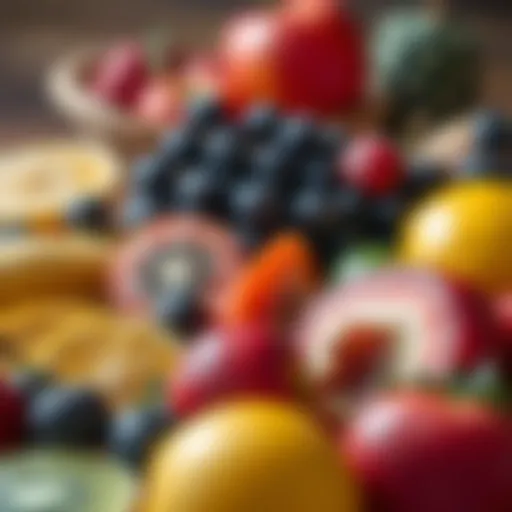Essential Techniques for Cleaning All-Clad Cookware
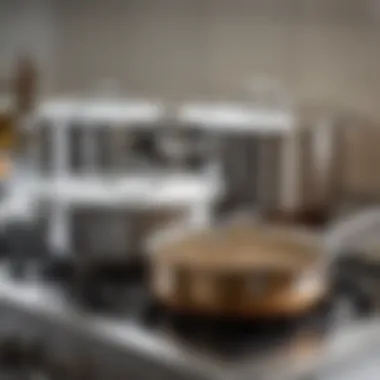

Intro
All-Clad cookware is like a trusty sidekick in the kitchen for many cooking enthusiasts. Its business end, made from high-quality stainless steel, boasts not just durability but also striking aesthetics that catch the eye. While the performance of this cookware deserves applause, maintaining its luster and functionality can be a bit of a chore without the right methods in place. This guide not only aims to demystify the cleaning process but also hopes to share insights into effective maintenance techniques to keep your All-Clad pieces looking sharp.
The following sections will delve into understanding what makes these cooking vessels special, and how to treat them with proper care. From breaking down essential tools and ingredients to answering those burning questions most people have when it comes to cleaning, this guide will cover everything you need to know. So, let’s roll up our sleeves and get into it!
Understanding All-Clad Cookware
All-Clad cookware has become a staple in many kitchens, prized for its resilience and top-notch performance. Understanding the intricacies of All-Clad not only aids in choosing the right piece for your culinary adventures but also helps maintain its aesthetic appeal and functional integrity over time. With the right insights, you can enhance your cooking experience while ensuring your investment lasts for years to come.
Material Overview
All-Clad cookware is primarily crafted from high-quality stainless steel, which features a distinctive aluminum or copper core. This specific combination of materials promotes even heat distribution, thereby reducing hot spots. Something you may find quite fascinating is that the construction employs a tri-ply or even multi-ply method, layering metals to achieve the perfect balance between durability and heat responsiveness.
Many cooks appreciate the ease of cleaning stainless steel, which often means a quick rinse or wipe down suffices after a meal prep. Furthermore, stainless steel is known for its ability to resist warping and scratching, making it a great long-term partner in your kitchen.
For enthusiasts who prioritize non-stick surfaces, All-Clad offers options that blend traditional materials with advanced non-stick coatings, allowing for healthier cooking with less oil. This flexibility can cater to a range of culinary styles, from searing meats to creating delicate sauces, giving you great versatility in your cooking repertoire.
Types of All-Clad Cookware
When it comes to navigating the world of All-Clad, there are several types you might encounter, each serving distinct cooking needs:
- Saucepans: Ideal for simmering sauces or cooking grains, these pots typically come with tight-fitting lids to maximize moisture retention.
- Skillets and Fry Pans: Excellent for tasks ranging from frying eggs to sautéing veggies, providing a non-stick interior for a seamless cooking experience.
- Stock Pots: With their generous size, they are perfect for boiling pasta or making large batches of broth, making them quite the workhorse in busy kitchens.
- Dutch Ovens: Good for slow-cooking and braising, they are versatile enough to transition from stovetop to oven.
- Grill Pans: Perfect for achieving those coveted grill marks indoors, serving up a taste of summer regardless of the season.
General Cleaning Principles
Maintaining All-Clad cookware goes beyond mere aesthetic upkeep. The general cleaning principles form the backbone of preserving functionality and enhancing longevity. When these principles are adhered to, it not only keeps your cookware in top shape but also ensures that every culinary creation bursts with flavor, unhindered by residual grime or old cooking oils.
Importance of Proper Maintenance
When we talk about cookware, it often gets a bad rap for being a stressful task to clean. However, proper maintenance can significantly reduce the time and effort needed to keep All-Clad cookware in its prime condition. This begins with recognizing its unique material composition and investing a little effort upfront can save hours of scrubbing later.
Using appropriate techniques not only keeps the cookware visually appealing, it also minimizes the risk of scratching or staining. With regular maintenance, you're essentially investing in the cookware longevity, enabling a seamless transition from home-cooked meals to family gatherings. In reality, a little bit of care equates to a disproportionate return on your culinary arsenal.
One must recognize that cookware isn’t just functional; it also serves as a canvas for culinary art. Imagine pulling out that spotless All-Clad frying pan for a gathering or a special dinner - it can set the tone for the entire meal.
Avoiding Harmful Chemicals
It can be tempting to reach for that bottle of strong cleaner when faced with a persistent stain, but a word to the wise: ditch the harsh chemicals! Many commercial cleaners contain ingredients that can cause unforeseen damage, stripping away the luster and integrity of your cookware. Instead, opt for gentler alternatives, which are usually just as effective without the risk.
Some effective and safe choices include:
- Baking soda, which acts as a gentle abrasive to tackle tough stains.
- Vinegar, known for its natural antibacterial properties and ability to cut through grease.
- Commercial cleaning products specifically designed for stainless cookware, often safer and more effective than generalized cleaners.
"Using the right cleaning products is like choosing the right ingredients for a dish; it makes all the difference."
Culmination
The principles of cleaning should never be taken lightly. By following the guidelines regarding proper maintenance and avoiding harmful chemicals, you're setting yourself up for success in your kitchen endeavors. This attention to detail ensures that your All-Clad cookware not only looks its best but also performs beautifully over time, turning every meal into an opportunity for culinary excellence.
Day-to-Day Cleaning Techniques
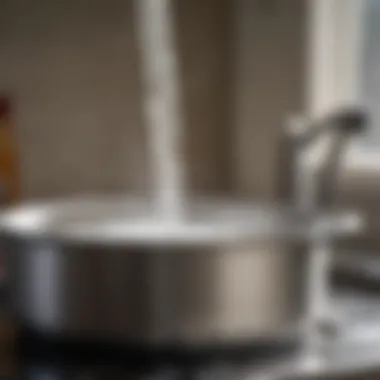

In the daily hustle and bustle of cooking, it can be all too easy to overlook the proper cleaning methods for your All-Clad cookware. However, establishing sound day-to-day cleaning techniques is vital for several reasons: they help maintain the cookware’s aesthetic appeal, prevent food residue build-up, and extend the longevity of these kitchen essentials. Proper cleaning not only ensures that your meals taste as they should, but also protects your investment in high-quality cookware.
Immediate Cleaning After Use
One of the most effective cleaning practices is addressing messes right after cooking. Leaving food residues on your All-Clad cookware can lead to stubborn spots that are harder to remove later. When you’re done cooking, take a moment—before the pans cool down completely—to rinse them with warm water. Not only does this help loosen any food particles, but it also makes subsequent cleaning much easier.
Here’s a simple step-by-step approach for immediate cleaning:
- Let it cool slightly: Don’t risk burns by trying to rush. Allow the pan to cool for a few minutes but don’t wait too long.
- Rinse with warm water: Use a gentle stream of warm water to help lift off food residues.
- Scrape off stubborn bits: If there are any bits stuck on the surface, use a soft spatula or a non-metal tool to gently dislodge them.
- Wash with mild soap: Next, use a few drops of dish soap and a non-abrasive sponge to clean it thoroughly.
- Rinse and dry: Always rinse your cookware well and dry it with a soft cloth to avoid water spots.
Remember, an ounce of prevention is worth a pound of cure. Taking a moment to clean right after use can save you serious scrubbing later.
Effective Handwashing Method
Even though many modern kitchens equip advise against handwashing, the best results come from a bit of old-fashioned elbow grease. Handwashing your All-Clad cookware not only helps maintain their finish but also ensures that you have a close-up view of any stubborn stains that may need more attention.
Here’s how to go about it:
- Gather your materials: Prepare a sponge, mild dish soap, a soft cleaning cloth, and warm water.
- Fill the sink with warm soapy water: Make sure it’s not scalding hot, just comfortably warm. This helps to dissolve grease and stuck on food.
- Scrub gently but thoroughly: Use your sponge to clean the surface of the cookware, paying special attention to corners and edges where food can get trapped.
- Avoid abrasive materials: Steer clear of steel wool or harsh scrubbers that can scratch the cooking surface.
- Rinse with warm water: Once you've cleaned the surface, rinse thoroughly to remove all soap residue.
- Dry immediately: Use a soft cloth to dry your cookware right away; this step is key to maintaining the gleaming finish.
In essence, a consistent, gentle handwashing routine not only keeps your All-Clad cookware looking new but also enhances its cooking performance. Following these day-to-day cleaning techniques, you’ll ensure that your trusty pots and pans will be in prime condition for years to come.
Addressing Stubborn Stains
Stubborn stains can be the bane of any culinary enthusiast. Although All-Clad cookware is renowned for its durability and ability to withstand high temperatures, it isn’t impervious to the unsightly marks that can result from regular use. Addressing these stains effectively is crucial not only to maintain your cookware's aesthetic appeal but also to preserve its functionality. After all, a clean and well-maintained pot or pan can make a remarkable difference in both preparation and presentation of your dishes.
Furthermore, tackling these stains promptly can help prevent permanent damage. It keeps your cookware in peak condition which, in turn, enhances your cooking experience. Let's delve into some methods that can help restore your All-Clad pieces to their original glory.
Using Baking Soda.
Baking soda has been a trusty ally in kitchens for ages, and for good reason. It’s a mild abrasive, which helps in scrubbing away stubborn marks without risking the surface of your All-Clad cookware. Here's how to go about it:
- Create a Paste: Mix equal parts of baking soda and water to form a paste. The consistency should be similar to thick yogurt.
- Apply the Paste: Spread the paste over the stained area and let it sit for 15-20 minutes. This gives time for the baking soda to work its magic.
- Scrub Gently: Using a soft sponge or cloth, scrub the stained area in a circular motion. Avoid using harsh steel wool or scouring pads, as they can scratch the surface.
- Rinse Thoroughly: After scrubbing, rinse your cookware under warm water. Ensure that all baking soda residue is cleaned off, as it can leave a gritty texture if left behind.
This method is gentle yet effective, allowing you to tackle grimy residue such as burnt food or grease without compromising the integrity of your beloved cookware.
Applying Vinegar Solutions
Vinegar, that humble kitchen staple, holds a world of potential when it comes to cleaning. Its acidic nature makes it a perfect candidate for breaking down stubborn stains and removing mineral deposits. Here’s a simple way to use vinegar for your All-Clad cookware:
- Dilute the Vinegar: Mix one part white vinegar with two parts water in your All-Clad cookware. This creates a solution strong enough to deal with stains but gentle on the metal.
- Heat the Solution: Place the cookware on the stove and heat the solution to a simmer. Let it simmer for a few minutes; this will help release the grip of the stains.
- Wipe Down: After simmering, take it off the heat and let it cool. With a soft cloth or sponge, wipe the stained areas. For tougher marks, a little more scrubbing might be required.
- Rinse: Finally, rinse your cookware with warm water and dry it thoroughly.
"Vinegar isn't just for salads; it's a powerful natural cleaner that can work wonders in the kitchen."
Using vinegar not only aids in stain removal but also leaves your cookware looking shiny and new - what's not to love?
Leveraging Commercial Cleaners
For those stains that simply refuse to budge, commercial cleaners provide a more potent avenue. These cleaners are designed specifically for stainless steel and can be invaluable in your cleaning arsenal. However, caution is essential when selecting and applying these products:
- Choose Wisely: Check the label to ensure the product is safe for stainless steel. Some cleaners might be too harsh and could harm the finish of your All-Clad cookware.
- Follow Instructions: Each cleaner will come with its own instructions and recommended usage guidelines. It’s vital to follow these to avoid any mishaps.
- Application: Typically, you’ll apply the cleaner directly to the stained area using a soft cloth. Gently rub it in according to the product’s instructions.
- Final Rinse: Rinse off any residue thoroughly to ensure no chemical remnants remain on your cookware, which could affect food.
Using commercial cleaners can be a lifesaver if you find yourself battling persistent stains, bringing back that shine you thought was long gone.
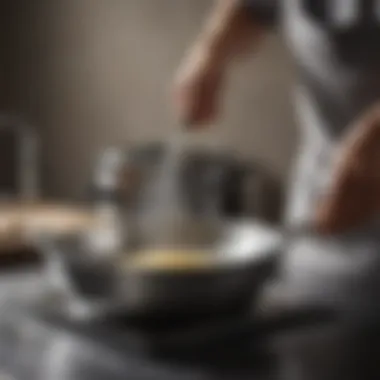

In summary, addressing stubborn stains on your All-Clad cookware doesn’t have to be a daunting task. Simple methods utilizing baking soda and vinegar can tackle many cleaning challenges, while commercial cleaners offer a stronger punch for those particularly tough stains. A little effort goes a long way in maintaining your cookware and, by extension, the pleasure of cooking.
Long-term Care and Maintenance
Taking proper care of your All-Clad cookware goes a long way in preserving its beauty and function. Long-term maintenance can often be the unsung hero of kitchen equipment care. Without a few simple habits, your beloved pots and pans can start showing signs of wear and tear, making them less enjoyable to use and less effective at cooking. Not only does neglecting long-term care impact the look of your cookware, but it also hampers its performance.
Developing a routine that involves keeping those intricate surfaces polished and avoiding unnecessary damage during storage can extend the life of your cookware significantly. By nurturing your All-Clad pieces over time, you can ensure they remain a staple of your culinary adventures.
Regular Polishing Techniques
To keep your All-Clad cookware shining like it's just out of the box, polishing is key. Regular polishing isn’t just for aesthetics; it helps in removing minor scratches and stains that can contribute to long-term deterioration. There are a couple of ways you can go about this task:
- Using a gentle polish: There are several metal polishes on the market specifically designed for stainless steel. Look for products that don’t have abrasive compounds. These will clean while being kind to the surface.
- Homemade solutions: You can also use home remedies, such as a mixture of baking soda and water to form a paste. Apply this gently with a microfiber cloth and buff out the surface. Always rinse thoroughly and dry after polishing to prevent any residue buildup.
A well-maintained pot reflects more than just good looks; it ensures excellent cooking performance.
Consistency in polishing, perhaps once a month or so depending on usage, will show dividends with time. You might find that those initial efforts contribute to a pot that looks and performs superbly, even after years of culinary escapades.
Storage Considerations
Where you keep your All-Clad cookware can also influence its longevity. Proper storage helps prevent dings, scratches, and other forms of damage that can happen when pots and pans bump against one another. Here are some effective strategies:
- Separate layers: If you're using multiple pots and pans, consider placing kitchen towels or soft liners between them. This creates a barrier that helps to avoid scratches.
- Use pot racks: Hanging your cookware can keep them from stacking and scratching against each other. Plus, it makes for an attractive storage solution if your kitchen allows for it.
- Avoid stackables: If you can, try not to stack your All-Clad items. Instead, find shelving or cabinets that allow for individual standing, reducing the chances for accidental wear.
Ultimately, your storage setup should not only protect your cookware but also give you easy access, making your cooking experience more enjoyable.
Embracing these long-term care strategies ensures that your All-Clad cookware will be ready for any culinary challenge, maintaining its sheen and effectiveness for many meals to come.
Common Errors to Avoid
When it comes to maintaining All-Clad cookware, avoiding common pitfalls is critical for preserving both its aesthetic and functional integrity. These errors can exacerbate wear, diminish performance, and even lead to costly replacements. By understanding and steering clear of these missteps, you can enhance the lifespan of your cookware and ensure it continues to serve you well for years to come.
Avoiding Metal Utensils
One significant error many home cooks make is using metal utensils on their All-Clad pots and pans. Metal utensils, such as spatulas or forks, can scratch the surface of your cookware, leading to a dull appearance. Unlike some other brands, All-Clad often has polished stainless steel surfaces, which are particularly susceptible to these imperfections.
To avoid this problem, consider using silicone, wood, or plastic utensils. These materials are gentle on cookware and don't leave behind marks. Not only do they prevent scratches, but they also contribute to a better cooking experience since they won't react with food like metal can.
Incorporating a habit of reaching for the right utensils can save you the trouble of repairing or replacing damaged cookware—definitely a win-win scenario.
Proper Heat Management
Heat management plays a crucial role in the longevity of your All-Clad cookware. Overheating can cause warping or other permanent damage. Many people still believe that cranking the heat up high is better for cooking; however, this can backfire, especially with stainless steel cookware.
Instead, learn to manage and adjust your heat correctly:
- Start with Medium Heat: Stainless steel heats evenly, so there's no need to blast it. Medium heat is typically sufficient for most cooking tasks.
- Preheat Gradually: If you're sautéing or searing, allow the pan to heat gradually. After a minute or so, you can check if it's hot enough by adding a drop of water; it should sizzle.
- Use Residual Heat: Cooking with All-Clad allows for great residual heat. If you’re simmering or keeping something warm, consider turning off the heat a few minutes early while it continues to cook.
By ensuring that you're using appropriate temperatures, you not only prolong the life of your pots and pans but also achieve better cooking results—no more burned or dried-out meals!
Remember: Proper heat management protects the integrity of your cookware and improves your overall cooking experience.
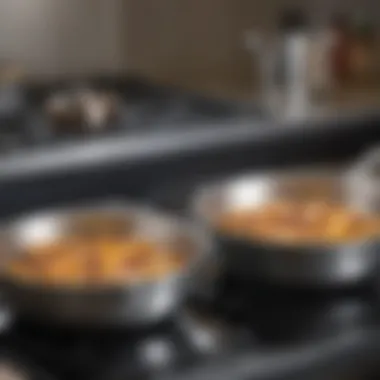

In summary, focusing on the simple yet effective strategies of avoiding metal utensils and mastering proper heat management can save your All-Clad cookware from premature wear and tear, ensuring it remains the staple of your kitchen.
Troubleshooting Issues
Maintaining All-Clad cookware comes with its share of challenges. Understanding how to troubleshoot common issues ensures that your pots and pans not only look good but also perform optimally. By addressing problems effectively, you can extend the lifespan of your cookware and keep your culinary adventures thriving. The importance of mastering troubleshooting lies in being proactive rather than reactive, avoiding minor inconveniences from turning into costly replacements.
Discoloration Problems
All-Clad cookware, known for its gleaming finish, can occasionally develop discoloration. This isn’t just an eyesore; it can affect the cooking performance. Factors like overheating, usage of acidic ingredients, or even improper cleaning can lead to unsightly stains.
To tackle discoloration, here are some steps to consider:
- Assess the Root Cause: Identify when the discoloration occurred. If it's due to high heat, adjusting your cooking habits might prevent future issues.
- Use a Gentle Abrasive: A paste made of baking soda and water can be effective. Apply it on the discolored areas and scrub gently with a sponge.
- Try Commercial Cleaners: If home remedies fail, there are dedicated stainless steel cleaners available. Just ensure they’re suitable for All-Clad’s materials.
Here’s a tip: Always dry your cookware immediately after washing to prevent water spots and further discoloration. A quick wipe down can keep your pieces looking sharp.
"Discoloration isn’t the end of the line; it’s a call to refine care methods."
Warping and Damage
Another significant concern with All-Clad cookware is warping and physical damage. Such issues not only impact aesthetics, but they can also inhibit proper cooking as warped surfaces may not hold heat evenly. Recognizing the signs and causes of warping is essential to strive for corrective action.
Common reasons for warping include:
- Extreme temperature changes: Moving hot cookware directly to cold water can create stress and cause warping.
- Wrong heating methods: Using too high of a flame or heating an empty pan can lead to physical deformation.
Here’s how to prevent or address warping:
- Avoid Rapid Cooldowns: Allow cookware to cool gradually after cooking.
- Check for Manufacturer's Guidelines: Each All-Clad piece may have specific care instructions that can help minimize damage.
- Inspect Regularly: Keep an eye on your cookware for signs of warping as a precautionary measure. If you notice a warped pan, consider replacing it, as it may inhibit cooking performance.
In either case of discoloration or warping, it’s good to remember that care strategies may not be immediately apparent. It's by investigating these issues we learn the ins and outs of keeping our prized kitchen gear in top shape.
Final Thoughts on Maintaining All-Clad Cookware
When it comes to All-Clad cookware, keeping it in top shape is no small feat. It’s more than just a cooking tool; it's an investment for your kitchen. Proper maintenance not only helps in preserving its stunning looks but also boosts its cooking efficiency and lifespan. The value of your cookware isn't just measured in dollars but also in the countless meals and memories created around it.
The Importance of Maintenance
Effective maintenance involves not just cleaning but understanding the multi-layered construction of All-Clad pots and pans. These items are crafted with layers of stainless steel around aluminum. The construction is smart; it provides superb heat distribution and durability. However, if you let grime settle in or neglect minor scratches, you might find yourself facing problems that disrupt the cooking experience.
Consider the benefits of maintaining your All-Clad cookware:
- Longevity: Taking care of your cookware can significantly extend its life. This is especially important for those who love to experiment with different cooking techniques.
- Performance: A well-maintained pan heats more evenly, enhancing your culinary creations.
- Aesthetic Appeal: Retaining the shine of the cookware elevates the overall feel of your kitchen.
Addressing Common Concerns
There are some lingering worries that home cooks often have concerning their All-Clad investment. One common concern is discoloration. Let’s break this down: It’s a sign of burnt-on oils or mineral deposits from hard water. Regular cleaning routines and preventative measures—like avoiding metal utensils—can ensure these problems don’t become chronic.
Another issue is warping. Warping typically stems from drastic temperature changes. Understanding how to heat your pans and when to cool them down is vital. Remember, prevention is often less of a headache than dealing with a warped pan after a meal gone awry.
Wrapping Up: The Balance of Usage and Care
Ultimately, maintaining All-Clad cookware comes down to a balance of usage and care. Whether you’re searing meat or simmering sauces, you should simultaneously keep cleaning routines at the forefront of your mind. Good cookware is indeed a canvas for culinary expression, but like any canvas, it requires the right touch to keep it pristine. It's like tending a garden; regular care will yield the best results.
All said and done, with thoughtful attention, your All-Clad cookware can remain the shiny star of your kitchen, performing beautifully for many years to come.
Invest in your cookware, and it will invest back in your culinary journey.
For further insights on cookware and culinary tips, feel free to visit Wikipedia or join discussions on Reddit.

